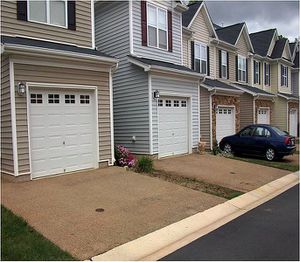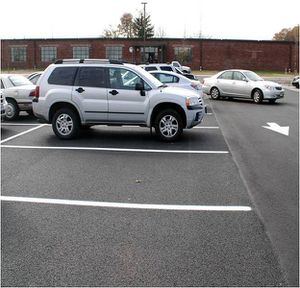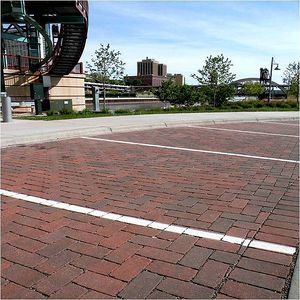
The anticipated construction period for this page is January through March, 2013
The anticipated review period for this page is January through March, 2013
The most commonly used permeable pavement surfaces are pervious concrete, porous asphalt, and permeable interlocking concrete pavers. Lesser utilized options include plastic and concrete grids, as well as amended soils (artificial media added to soil to maintain soil structure and prevent compaction) (MPCA 2008). For the purpose of this document, the focus is on pervious concrete, porous asphalt and permeable interlocking concrete pavements.
For each of the above pavement surfaces, there are many variants depending on the design goals. For instance, permeable pavement can be installed with a deep underlying reservoir consisting of open-graded, crushed rock. This design provides water quality and quantity control by storing runoff and infiltrating it into the subgrade soils over an extended period of time. A second design variation includes a deep underlying reservoir consisting of open-graded, crushed rock above an impermeable layer of soil or a liner and an underdrain. The underdrain typically discharges to a stormwater pond or storm sewer system. This design provides some runoff flow attenuation, filtering, but no volume reduction. These two options provide different levels of treatment.
To assist with selection of a permeable pavement type, a general comparison of the properties of the three major permeable pavement types is provided in the table below. Designers should check with product vendors and the local review authority to determine specific requirements and capabilities of each system. Schematic cross sections of each system are illustrated in the design section for permeable pavement.
Summary of properties of permeable pavements.
Link to this table
| Properties | Pervious concrete | Porous asphalt | PICP |
|---|---|---|---|
| Typical pavement surface thicknessa | 5 to 8 inches | 3 to 4 inches (thicker for high wheel load applications) | 3 inchesa |
| Bedding layera,f | None | 1 in. AASHTO No. 57 stone | 2 inches of AASHTO No. 8 stone (MnDOT 3127 FA-3) |
| Reservoir layerb,f | AASHTO No. 57 stone or per hydraulic design | AASHTO No. 2, 3, or 5 stone | 4 inches of AASHTO No. 57 stone over No. 2, 3 or 4 stone |
| Construction properties |
|
|
|
| Installed surfacing costc | 3 to $4/square foot | $2/square foot | 3 to $4/square foot |
| Minimum batch size | |||
| Longevityd | |||
| Overflow | |||
| Runoff temperature reduction | |||
| Surface colors/texture | Range of light colors and textures | Black or dark grey colors | Wide range of colors, textures and patterns |
| Load bearing capacitye | |||
| Surface cleaningg | Periodic vacuuming; replace jointing stones if completely clogged and uncleanable | ||
| Other issues |
|
|
Avoid winter sanding |
| Design references | [1] | [2] | [3] |
aThickness may vary depending on site and traffic conditions
bReservoir storage may be augmented by corrugated metal pipes, plastic arch pipe or plastic lattice crates
cSupply and install minimum surface thickness only; minimum 30,000 sf with Minnesota 2012 prevailing labor wages. Does not include base reservoir, drainage appurtenances, engineering, or inspection
dBased on pavement being properly maintained. Resurfacing or rehabilitation may be needed after the indicated period
eDepends primarily on on-site geotechnical considerations and structural design computations
f ASTM D448 Standard Classification for Sizes of Aggregate for Road and Bridge Construction or ASASHTO M-43
gPeriodic vacuuming frequency determined from inspection, intensity of use, and other potential sediment sources


